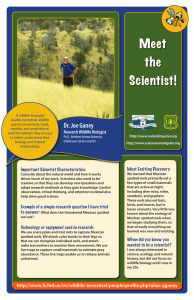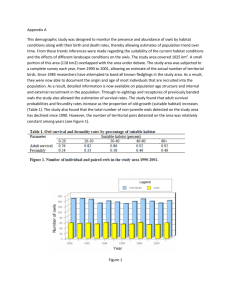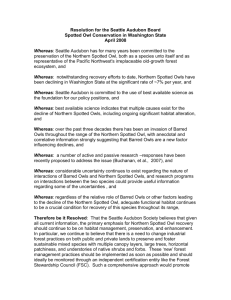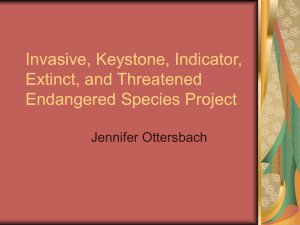Survival Rates of Northern Spotted Owls in Post-fire Landscapes of
advertisement
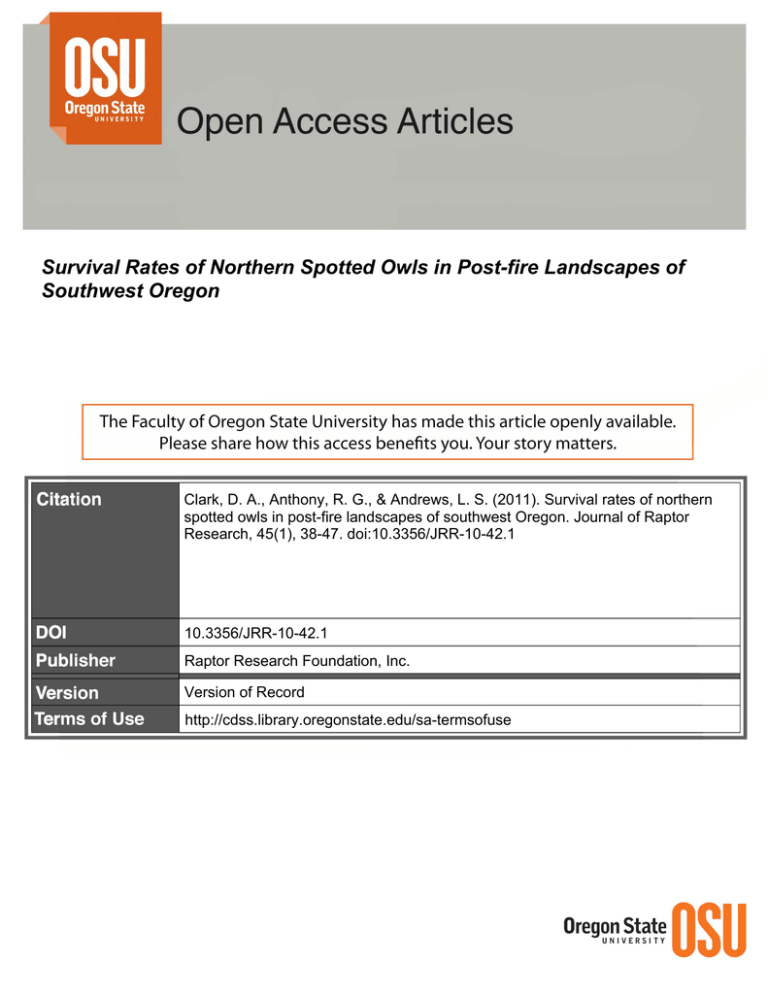
Survival Rates of Northern Spotted Owls in Post-fire Landscapes of Southwest Oregon Clark, D. A., Anthony, R. G., & Andrews, L. S. (2011). Survival rates of northern spotted owls in post-fire landscapes of southwest Oregon. Journal of Raptor Research, 45(1), 38-47. doi:10.3356/JRR-10-42.1 10.3356/JRR-10-42.1 Raptor Research Foundation, Inc. Version of Record http://cdss.library.oregonstate.edu/sa-termsofuse J. Raptor Res. 45(1):000–000 E 2011 The Raptor Research Foundation, Inc. SURVIVAL RATES OF NORTHERN SPOTTED OWLS IN POST-FIRE LANDSCAPES OF SOUTHWEST OREGON DARREN A. CLARK1, ROBERT G. ANTHONY AND LAWRENCE S. ANDREWS Oregon Cooperative Fish and Wildlife Research Unit, Oregon State University, Corvallis, OR 97331 U.S.A. ABSTRACT.—We estimated annual survival rates (S) of 23 radio-marked Northern Spotted Owls (Strix occidentalis caurina) at the Quartz and Timbered Rock burns and adjacent areas in southwest Oregon. We used known-fate models in program MARK to test for differences in survival among three groups (owls dwelling inside of burned areas, owls displaced by wildfire, and owls dwelling outside of burned areas) and to investigate the potential effects of fire severity and cover type on survival. We found that annual survival rates of Spotted Owls that maintained a territory within the burn perimeter (Ŝ 5 0.69 6 0.12) or that had been displaced by the burn (Ŝ 5 0.66 6 0.14) were lower than those owls that had territories outside but adjacent to the burn perimeter (Ŝ 5 0.85 6 0.06). This result indicated that wildfire had a negative impact on Spotted Owl survival, at least in the short-term (i.e., 3–5 yr post-burn). We were unable to identify a significant effect of fire severity or quantity of habitat on Spotted Owl survival, but this inability was likely related to our small sample size and high variability in habitat composition. We recommend long-term monitoring of survival on larger samples of owls to identify the effects of fire severity and habitat on Spotted Owl survival and to determine if wildfire poses a significant threat to the long-term persistence of Spotted Owls. KEY WORDS: Northern Spotted Owl; Strix occidentalis caurina; known-fate models; post-burn survival; radiotelemetry; wildfire. TASAS DE SUPERVIVENCIA DE STRIX OCCIDENTALIS CAURINA EN PAISAJES CON INFLUENCIA DE INCENDIOS EN EL SUDOESTE DE OREGON RESUMEN.—Estimamos las tasas anuales de supervivencia (S) de 23 individuos de Strix occidentalis caurina marcados con radiotransmisores en las áreas quemadas de Quartz y Timbered Rock y áreas adyacentes en el sudoeste de Oregon. Usamos modelos de destino conocido en el programa MARK para determinar si existen diferencias entre tres grupos (lechuzas que habitan áreas quemadas, lechuzas que fueron desplazadas por el fuego y lechuzas que habitan fuera de las áreas quemadas) y para investigar los efectos potenciales de la severidad del fuego y del tipo de cobertura sobre la supervivencia. Encontramos que las tasas de supervivencia anuales de los individuos que mantuvieron sus territorios dentro del perı́metro quemado (Ŝ 5 0.69 6 0.12) y de los individuos que fueron desplazados por los incendios (Ŝ 5 0.66 6 0.14) fueron más bajas que las de los individuos que tenı́an territorios adyacentes pero fuera del perı́metro quemado (Ŝ 5 0.85 6 0.06). Este resultado indica que los incendios forestales tuvieron un impacto negativo en la supervivencia de S. occidentalis caurina, por lo menos en el corto plazo (i.e., 3–5 años después de los incendios). No fuimos capaces de detectar un efecto significativo de la severidad del fuego o de la cantidad de hábitat sobre la supervivencia de las lechuzas, pero esta inhabilidad de detectar un efecto probablemente SE relacionó con nuestro pequeño tamaño de muestra y con la gran variabilidad en la composición del hábitat. Recomendamos un monitoreo a largo plazo de la supervivencia con tamaños de muestra mayores para identificar los efectos de la severidad del fuego y del hábitat sobre la supervivencia de estas lechuzas y para determinar si los incendios forestales representan una amenaza para la persistencia en el largo plazo de S. occidentalis caurina. [Traducción del equipo editorial] The Northern Spotted Owl (Strix occidentalis caurina; hereafter Spotted Owl) was listed as threatened by the U.S. Fish and Wildlife Service in 1990 1 (USFWS 1990). At that time, the primary reasons for listing included loss of habitat to timber harvest, evidence of declining populations, and lack of regulatory mechanisms to protect the owl or its habitat. In 1994, the Northwest Forest Plan (NWFP) was Email address: Darren.Clark@oregonstate.edu 0 The Journal of Raptor Research rapt-45-01-04.3d 7/1/11 17:09:18 38 Cust # JRR-10-42 MARCH 2011 SPOTTED OWL SURVIVAL AFTER FIRE adopted to protect habitat for Spotted Owls and other late-successional forest dependent species (Thomas et al. 1993) and to reduce timber harvest on federally managed lands (USDA and USDI 1994). Since the adoption of the NWFP, several Spotted Owl populations have continued to decline despite increased habitat protection and large reductions in timber harvest on public lands (Anthony et al. 2006, USFWS 2008). Ongoing population declines are thought to be related to low apparent survival (Anthony et al. 2006), competition with Barred Owls (Strix varia; Kelly et al. 2003, Olson et al. 2005), and habitat loss from natural disturbances, particularly wildfire (USFWS 2008). The likelihood of stand-replacing wildfire in the dry forest physiographic provinces of the Pacific Northwest increased during the latter half of the twentieth century (Agee 1993). Increased fire frequency caused wildfire to become the leading factor contributing to Spotted Owl habitat loss on public lands (Davis and Lint 2005). Although losses of Spotted Owl habitat to wildfire throughout the species’ range equaled predicted losses (Davis and Lint 2005), loss of habitat to wildfire within the dry forest physiographic provinces exceeded predictions (Davis and Lint 2005). The increased frequency of habitat loss to wildfire caused concern for the viability of Spotted Owl populations in dry forest ecosystems (Spies et al. 2006) and contributed to the identification of wildfire as a threat to Spotted Owls (USFWS 2008). Although the threat of wildfire to Spotted Owls has increased, little is known about the effects of wildfire on the demographic rates of Spotted Owls, particularly survival rates. Survival rates of Northern, Mexican (S. o. lucida) and California Spotted Owls (S. o. occidentalis) one year post-fire were similar to rates reported throughout the species’ ranges (Bond et al. 2002). Other studies indicated that occupancy of territories by Spotted Owls declined following wildfire (MacCracken et al. 1996, Gaines et al. 1997). However, it was unknown whether occupancy declines were attributable to emigration from the burned area or to decreased survival. Studies conducted in landscapes that were not recently affected by wildfire suggested that Spotted Owl survival was positively associated with increased amounts of late-successional forest (Franklin et al. 2000, Olson et al. 2004, Dugger et al. 2005) and negatively associated with increased amounts of early seral forests (Dugger et al. 2005). These studies suggest that 0 intense wildfire that destroys or severely alters older forests may negatively impact Spotted Owl survival. Conversely, higher survival rates were observed at Spotted Owl territories that were not entirely composed of late-successional forests (Franklin et al. 2000, Olson et al. 2004), which may suggest that Spotted Owls have adapted in some ways to wildfire, which creates forest heterogeneity. Several large wildfires in southwest Oregon during the summers of 2001 and 2002 provided an opportunity to study Spotted Owl survival in burned landscapes. Our objectives were to estimate survival rates of Spotted Owls dwelling in burned areas, those displaced by wildfire, and those dwelling outside of burned areas, and to assess the potential effects of fire severity and habitat covariates on survival rates. We predicted that survival rates of Spotted Owls inside burned areas or displaced by wildfire would be lower than those that were outside but adjacent to burned areas. We also predicted that survival rates would be positively associated with greater amounts of older forests that were unburned or burned with a low to moderate severity and negatively associated with greater amounts of high severity burns and salvage logging within individual owl’s home ranges. METHODS Study Areas. We estimated Spotted Owl survival within and around the Quartz and Timbered Rock burns in southwest Oregon. The Timbered Rock and Quartz burns were located approximately 45 km and 21 km from Medford, Oregon, respectively. Forest types in this portion of the Spotted Owl’s range were part of the mixed-conifer and mixed-evergreen vegetation zones (Franklin and Dyrness 1973). Common tree species on our study areas included ponderosa pine (Pinus ponderosa), sugar pine (Pinus lambertiana), Douglas-fir (Psuedotsuga menziesii), incense cedar (Calocedrus decurrens), white fir (Abies concolor), Oregon white oak (Quercus garryana), California black oak (Quercus kellogii), and Pacific madrone (Arbutus menziesii). Prior to active fire suppression, most of southwestern Oregon was characterized by frequent low-intensity fires at low elevations and infrequent stand-replacing fires at high elevations (Agee 1993). The climate regime in this portion of Oregon is characteristically temperate with hot, dry summers and cool, moist winters. During our study, average annual rainfall was 66 cm at the Quartz burn and 88 cm at the Timbered Rock burn. The warmest and coldest average The Journal of Raptor Research rapt-45-01-04.3d 7/1/11 17:09:23 39 Cust # JRR-10-42 0 CLARK ET AL. VOL. 45, NO. 1 Table 1. The percentage of area within the Quartz and Timbered Rock burns that was classified as nonhabitat or Northern Spotted Owl habitat that was salvage logged or burned with a low, moderate, or high severity. PERCENT OF STUDY AREA HABITATa STUDY AREA NON-HABITATb LOW SEVERITY c MODERATE SEVERITY d HIGH SEVERITY e SALVAGE LOGGED f Timbered Rock Quartz 27.10% 28.20% 30.50% 17.10% 12.30% 13.40% 10.10% 18.80% 20.00% 22.50% a Forested areas that provide nesting, roosting, and/or foraging habitat for Spotted Owls. Non-forested areas and early seral forests as a result of prior logging activities. c #20% of the overstory removed by wildfire. d .20% but #70% of the overstory removed by wildfire. e .70% of the overstory removed by wildfire. f Areas that received any level of post-fire salvage. b daily temperatures occurred in July (21uC) and December (3uC), respectively (Oregon Climate Service, Oregon State University, unpubl. data). The Quartz Fire was ignited by lightning in August 2001, and burned 2484 ha within the Glade Creek, Little Applegate, and Yale Creek watersheds at elevations ranging from approximately 600 to 1850 m. Land ownership was a mixture of public (US Forest Service [USFS], Bureau of Land Management [BLM], and Oregon Department of Forestry ODF]) and private. The site centers of nine documented Spotted Owl territories were within the perimeter of the Quartz Fire. From 2003 to 2006, the number of territories occupied by a pair of Spotted Owls ranged from two to five. One occupied territory that was adjacent to the burn was also monitored as part of this study. The study area burned with a mosaic of low, moderate, and high severities, and substantial areas within the study area received primarily clear-cut salvage logging (Table 1). The Timbered Rock Fire was ignited by lightning in mid-July, 2002, and burned approximately 11 028 ha within the Elk Creek watershed at elevations ranging from 450 to 1350 m. Land ownership was a checkerboard pattern of public (BLM) and private lands in the southern two-thirds of the burn and contiguous USFS-managed lands in the northern third. Twenty-two Spotted Owl territories were within the perimeter of the Timbered Rock Fire and were monitored as part of this study. From 2003 to 2006, the number of territories occupied by a pair of Spotted Owls declined from eight to three. Five additional occupied territories that were adjacent to the burn were monitored as part of this study. The study area burned in a mosaic of fire severities and had large amounts of primarily clear-cut salvage logging (Table 1). Owl Capture and Monitoring. Between September 2004 and June 2005 we captured and radiomarked 23 Spotted Owls in the Timbered Rock and Quartz burns and surrounding areas. We located Spotted Owls at known territory centers using acoustic surveys (Franklin et al. 1996). After locating individual owls, we captured and radio-marked owls using methods outlined by Guetterman et al. (1991). Owl capture and handling followed the guidelines of the Institutional Animal Care and Use Committee at Oregon State University (IACUC Number 3040). Of the 23 radio-marked owls, 11 were inside burned areas (five females, six males), six were displaced by the burns (three females, three males), and six were outside burned areas (three females, three males). Owls that were displaced by the burn were defined as color-banded owls that occupied a territory inside the burn for at least 1 yr post-burn and established a territory outside the burn $2 yr post-burn, where they were radiomarked. On average, owls that were displaced by the burn moved 3.4 km (range 2.3–7.0 km) from their original territory to an unoccupied territory adjacent to the burn perimeter. We fitted each owl with a 7.5-g backpack-mounted radio-transmitter equipped with a mortality sensor (Holohil Systems Ltd. Model RI-2C, Ontario, Canada). We recorded the fate (alive or dead) of individual owls from October 2004 through September 2005 by monitoring transmitter signals approximately every second day. When we could not locate an individual from the ground, we conducted aerial searches using fixedwing aircraft. If we could not locate the owl following an aerial search, we assumed the transmitter failed or The Journal of Raptor Research rapt-45-01-04.3d 7/1/11 17:09:24 40 Cust # JRR-10-42 MARCH 2011 SPOTTED OWL SURVIVAL AFTER FIRE 0 Table 2. Description of a priori hypotheses and models used for testing the effects of temporal and group factors on Northern Spotted Owl survival at the Quartz and Timbered Rock burns and adjacent areas in southwest Oregon, U.S.A. HYPOTHESIS DESCRIPTIONa MODEL NOTATION TEMPORAL EFFECTS 1. Survival rates are constant among months 2. Survival rates differ among months 3. Survival rates follow a linear trend 4. Survival rates follow a log-linear trend 5. Survival rates follow a quadratic trend S S S S S (.) (t) (T) (lnT) (TT) GROUP EFFECTS 6. Owls inside the burn or displaced by the burn (Affected) have equal survival rates that are different from those of owls outside the burn (Unaffected) 7. Same as model 6, but survival also varies by sex 8. Owls inside the burn, displaced by the burn, and outside the burn have different survival rates 9. Same as model 8, but survival also varies by sex 10. Owls outside or displaced by the burn (Outside) have equal survival rates that are different than owls inside the burn (Inside) 11. Same as model 10, but survival also varies by sex 12. Survival varies by sex, but not by area a S (Affected ? Unaffected) S (Affected ? Unaffected * Sex) S (Area) S (Area * Sex) S (Inside ? Outside) S (Inside ? Outside * Sex) S (Sex) Additive and interactive combinations of temporal and group effects were considered when appropriate. the owl emigrated from the study area. When this happened the individual was censored during the periods of unknown fate. If the transmitter indicated a mortality (i.e., the pulse rate of the transmitter doubled), we located the carcass or remains of the owl as soon as possible to determine the cause of death. If the cause of death could not be determined in the field, we submitted the owl carcass for necropsy at the Veterinary Diagnostic Lab (VDL) at Oregon State University, College of Veterinary Medicine. Estimation of Survival Rates. We estimated monthly survival rates (S) in program MARK using known-fate models for radio-marked individuals (White and Burnham 1999). We used a modified Kaplan-Meier (1958) estimator that allowed for staggered data entry and censoring of individuals (Pollock et al. 1989). We entered owls into the dataset during the first month they were monitored and censored owls during intervals of unknown fate. We compounded monthly survival rates over 12 mo to obtain an estimate of annual survival. We modeled survival using a two-step process. First, we developed a set of candidate models, based on biologically plausible hypotheses to test for differences in survival among groups over time (Table 2). We used previously outlined approaches when building and naming our candidate model set (Lebreton et al. 1992, White and Burnham 1999). We investigated models that incorporated five time effects (Table 2). In addition, we investigated candidate models based on potential differences among six groups; females and males inside burned areas, females and males displaced by the burn (color-banded owls that had a territory inside the burn 1 yr post-burn and established a territory outside the burn $2 yr following the burn), and females and males outside but adjacent to the burn perimeter (Table 2). We developed seven candidate models to test for differences among these groups (Table 2). Models with $2 groups included additive (+) and interactive (*) combinations of group and time when appropriate. For example, if the linear trend (T) model ranked higher than the constant survival (.) model, the linear trend was modeled as an interactive and additive effect with the group. Second, we modeled individual covariates for habitat within each owl’s home range as an additive effect with the best model from step one. To assess the impacts of fire severity and cover type on Spotted Owl survival, we created post-fire habitat maps in ArcGIS 9.1 (ESRI, Redlands, California, U.S.A.) by merging three data layers: (1) a pre-fire habitat map (Davis and Lint 2005), (2) a fire severity map, and (3) the boundaries of salvage The Journal of Raptor Research rapt-45-01-04.3d 7/1/11 17:09:24 41 Cust # JRR-10-42 0 CLARK ET AL. logged areas (see Clark 2007 for additional details). We used program KERNELHR to estimate 95% fixed kernel home ranges using least-squares cross validation to select the kernel bandwidth (Seaman and Powell 1996, Seaman et al. 1998). We calculated individual covariates as the proportion of each habitat type within an individual’s 95% fixed kernel home range. Due to our small sample of radiomarked owls and the large variation in covariate values (Appendix A), we developed a small set of candidate models (n 5 14) that had relatively few parameters. The two most complex covariate models we considered included four parameters [models S(LOW + MOD + HIGH + SALV) and S(RF + NRF + HIGH + SALV)]. We considered four models that included only one covariate [models S(LOST), S(LOW), S(NRF), and S(NRFL)]. The eight remaining candidate models were variations of the most complex models that had fewer parameters [e.g., models S(HIGH + SALV) and S(RF + NRF)] or combined the HIGH and SALV covariates into one parameter (LOST). Definitions for individual covariates are provided in Appendix A. We used Akaike’s Information Criteria corrected for small sample sizes (AICc) to rank candidate models (Burnham and Anderson 2002). We used the difference between the AICc of the best model and the ith model (DAICc) to identify closely competing models (Burnham and Anderson 2002). Any model within 2 DAICc units was considered competitive with the best model. We used Akaike weights to evaluate the relative support for each candidate model and compute model averaged monthly and annual survival estimates (Burnham and Anderson 2002). We calculated model-averaged survival estimates using models that had summed Akaike weights of 0.95. We calculated model-averaged survival estimates and associated standard errors in program MARK. Survival estimates are reported as the mean 6SE. To determine a significant effect of various factors in the model, we evaluated whether regression coefficients (b) and their associated 95% confidence interval overlapped 0. We calculated the coefficient of variation (CV 5 [SE(S)/S] 3 100) to evaluate the precision of our estimates. RESULTS Causes of Mortality. We radio-marked 23 Spotted Owls, 3–4 yr post-fire, at the Quartz and Timbered Rock burns and adjacent areas in southwest Oregon. From October 2004 to September 2005, five VOL. 45, NO. 1 of 23 radio-marked owls (22%) within and adjacent to the Timbered Rock and Quartz burns died. Four owl carcasses were submitted for necropsy at the VDL at Oregon State University, College of Veterinary Medicine. All four owls were severely emaciated and likely died of starvation. The VDL found no injuries attributable to the radio-transmitter package, and all owls tested negative for West Nile Virus (Flavivirus). One owl was not submitted for necropsy because only scattered feathers and the transmitter package were present at the recovery location, which suggested predation was the cause of death. One owl was censored from the analysis from April through May 2005 due to transmitter failure, but was reentered into the analysis in June 2005 after the transmitter was replaced. Survival Rates. The best model from the first step of our analysis was S(Affected ? Unaffected; Table 3). Our interpretation of this model was that survival rates were constant among months but lower for owls inside or displaced by the burns (0.96 6 0.02) compared to owls outside the burns (1.00 6 0.00). Two models [S(.) and S(Area)] were considered competitive (i.e., within 2 DAICc units) with the best model (Table 3). Model S(.) indicated that survival rates were constant among months (0.97 6 0.01) and that there were no differences among groups. Model S(Area) indicated that survival rates were constant among months, but owls outside, inside, and displaced by the burns had the highest (1.00 6 0.00), intermediate (0.97 6 0.02), and lowest (0.94 6 0.04) monthly survival rates, respectively. There was minimal evidence that survival rates varied by sex or were variable over time, because models that incorporated sex and time effects had greater AICc values than the null model [S(.)] (Table 3), and their 95% confidence intervals overlapped zero considerably. Eight models accounted for 95% of the model weight and all eight models had DAICc values ,4.00 (Table 3). We calculated model averaged annual survival estimates using these eight models. Model averaged estimates of annual survival for owls inside the burns (Ŝ 5 0.69 6 0.12) and displaced by the burns (Ŝ 5 0.66 6 0.14) were similar but were substantially lower than owls outside burned areas (Ŝ 5 0.85 6 0.06). Likely due to our small sample sizes, our estimates of annual survival did not have a high level of precision with CV values of 17.9%, 20.9%, and 7.3% for owls inside burned areas, displaced by burns, and outside burned areas, respectively. The Journal of Raptor Research rapt-45-01-04.3d 7/1/11 17:09:25 42 Cust # JRR-10-42 MARCH 2011 SPOTTED OWL SURVIVAL AFTER FIRE 0 Table 3. Model selection results for estimation of survival rates of Northern Spotted Owls (n 5 23) at the Timbered Rock and Quartz burns and surrounding areas in southwestern Oregon, U.S.A., from October 2004 to September 2005, using known-fates models. MODELa S S S S S S S S S S S S (Affected ? Unaffected) (.) (Area) (lnT) (T) (Sex) (Inside ? Outside) (TT) (Affected ? Unaffected * Sex) (Area * Sex) (t) (Area * Sex * t) - Global AICc DAICc wib Kc DEVIANCE 46.84 47.60 48.42 49.18 49.48 49.56 49.62 50.12 50.86 54.55 58.40 265.62 0.00 0.77 1.58 2.34 2.64 2.72 2.78 3.29 4.02 7.71 11.56 218.78 0.28 0.19 0.13 0.09 0.07 0.07 0.07 0.05 0.04 0.01 0.00 0.00 2 1 3 2 2 2 2 3 4 6 12 72 21.27 24.08 20.78 23.61 23.91 23.99 24.05 22.49 21.13 20.56 11.01 0.00 a Variable definitions: . 5 constant survival, t 5 survival varies by month, T 5 linear trend, lnT 5 log-linear trend, TT 5 quadratic trend. Affected ? Unaffected 5 owls inside or displaced by burns have different survival than owls burns, Area 5 owls inside burns, displaced by burns, and outside burns have different survival, Inside ? Outside 5 owls inside burns have different survival than owls outside or displaced by burns. b Model weight. c No. of parameters. None of the candidate models that included covariates ranked higher than the best non-covariate model (Table 4), which indicated the covariates explained little of the variation in survival rates. Furthermore, all of the regression coefficients associated with the covariates LOW, MOD, HIGH, SALV, RF, NRF, and LOST had 95% confidence intervals that broadly overlapped zero, indicating a nonsignificant effect of these covariates on survival rates. For example, the regression coefficient and the 95% confidence interval for the LOW parameter from the best covariate model [S(Affected ? Unaffected + LOW] (Table 4) was 24.11 (95% CI 5 210.39 2 2.17; CV 5 77.9%), which indicated a nonsignificant effect of this parameter on survival. DISCUSSION Mean annual survival rates of Spotted Owls displaced by wildfire (Ŝ 5 0.66 6 0.14) or living within burned areas (Ŝ 5 0.69 6 0.12) were lower than those outside burned areas in our study (Ŝ 5 0.85 6 0.06), which supported our initial prediction. Table 4. Model selection results for known-fates survival estimates of Northern Spotted Owls (n 5 23) at the Timbered Rock and Quartz burns and surrounding areas in southwestern Oregon, U.S.A., from October 2004 to September 2005, comparing the null model and the best non-covariate model to the four best ranked covariate models. MODELa S S S S S S (Affected (Affected (.) (Affected (Affected (Affected ? Unaffected) ? Unaffected + LOW) ? Unaffected + RF + NRF) ? Unaffected + LOST) ? Unaffected + NRFL) AICc DAICc wib Kc DEVIANCE 46.84 47.23 47.64 47.68 48.17 48.38 0.00 0.39 0.77 0.84 1.33 1.54 0.15 0.12 0.1 0.1 0.08 0.07 2 3 1 4 3 3 42.77 41.09 45.82 39.44 42.03 42.24 a Variable definitions: Affected ? Unaffected 5 owls inside or displaced by the burn have different survival that owls outside the burn, LOW 5 suitable habitat that was unburned or burned with a low severity, RF 5 roosting and foraging habitat that burned with a low or moderate severity, NRF 5 nesting, roosting, and foraging habitat that burned with a low or moderate severity, LOST 5 suitable habitat that burned with a high severity or was salvage logged, NRFL 5 nesting, roosting, and foraging habitat that was unburned or burned with a low severity. b Model weight. c No. of parameters. The Journal of Raptor Research rapt-45-01-04.3d 7/1/11 17:09:25 43 Cust # JRR-10-42 0 CLARK ET AL. These rates were also lower than estimates of apparent survival [Ŵ 5 true survival * (1 – the probability of permanent emigration)] of Spotted Owls in the South Cascades Demography Area (Ŵ 5 0.85 6 0.01) and other areas within the subspecies range (Ŵ 5 0.75–0.91 6 0.01–0.05; Anthony et al. 2006). Furthermore, annual survival estimates of owls affected by wildfire in our study were lower than apparent survival estimates of California (Ŵ 5 0.81– 0.88 6 0.02–0.02; Franklin et al. 2004) or Mexican Spotted Owls (Ŵ 5 0.81–0.83 6 0.00–0.02; Seamans et al. 1999). Although known-fate and apparent survival estimates are not directly comparable (W 5 S only when permanent emigration is negligible), we believe the comparison is useful because permanent emigration from demographic study areas was typically ,2–3% per yr (Forsman et al. 2002, Anthony et al. 2006). Consequently, Anthony et al. (2006) asserted that their estimates of apparent survival were relatively unbiased due to permanent emigration of territorial adults. We found no evidence for an effect of fire severity or quantity of habitat on Spotted Owl survival in our study. Consequently, we were unable to support or reject our predictions regarding the effects of these two factors on Spotted Owl survival. However, other studies indicated that Spotted Owl survival in landscapes that have not burned recently was positively associated with increased amounts of old and mature forest (Franklin et al. 2000, Olson et al. 2004, Dugger et al. 2005) and negatively associated with increased amounts of early seral forest (Dugger et al. 2005). High severity fire and salvage logging removed 30% and 41% of the habitat available at the Timbered Rock and Quartz burns, respectively (Table 1), and much (27–28%) of the remaining areas within the burns were composed of nonhabitat. Consequently, we suspect that past logging activities on federal and private lands plus loss of mature and older forest to high severity wildfire and salvage logging jointly contributed to the low survival rates observed in our study. Only 31 and 43% of the area within the Quartz and Timbered Rock burns were composed of habitat with low or moderate severity burns, respectively, and these amounts of habitat are below those needed for maximum survival of Spotted Owls (Franklin et al. 2000, Olson et al. 2004, Dugger et al. 2005). Further research is needed to clarify the relationship between wildfire and Spotted Owl survival. In addition to habitat loss, survival rates in postfire landscapes may be influenced by habitat degra- VOL. 45, NO. 1 dation in stands of low to moderate severity fire due to delayed tree mortality (Gaines et al. 1997), changes in microclimate (Barrows 1981), changes in prey abundance (Lehmkuhl et al. 2006), or increased predator abundance (Carey et al. 1992). Survival of territorial raptors is often influenced by prey abundance (Wenland 1984, Steenhof et al. 1997, Brommer et al. 1998). Clark (2007) found that post-fire owl diets in this study were dominated by woodrats (Neotoma spp.; 49% of biomass consumed), which is typical for this portion of the subspecies’ range (Forsman et al. 2004). Although we did not estimate small mammal abundance following wildfire, the severely emaciated condition of owls submitted for necropsy suggested that owls struggled to obtain food resources in post-fire landscapes. Furthermore, Clark (2007) found that home ranges of Spotted Owls following the Timbered Rock fire were 286 6 105 ha larger than those of owls that inhabited the pre-fire area in the late 1980s. We suspect that owls in post-fire landscapes utilized larger areas to obtain sufficient food resources, which required increased energy expenditures and ultimately influenced individual fitness (Carey et al. 1992, Ward et al. 1998). If wildfire reduced prey abundance and negatively affected Spotted Owl survival, we suspect the effects are short in duration and survival rates will increase over time as habitat and prey abundance return to pre-fire conditions. Competition with Barred Owls has been identified as one of the major threats to the persistence of Spotted Owls (USFWS 2008). Barred Owls have a more generalist diet (Hamer et al. 2001) and utilize a wider range of habitats (Hamer et al. 2007) than Spotted Owls, and Barred Owls appear to decrease territory occupancy of Spotted Owls (Kelly et al. 2003, Olson et al. 2005). During our demographic surveys of nine Spotted Owl territories at the Quartz burn and 22 Spotted Owl territories at the Timbered Rock burn from 2003 to 2006, we detected only one Barred Owl (Oregon Cooperative Wildlife Research Unit, unpubl. data). This indicated that Barred Owls were not abundant on our study areas and were not a potential influence on survival of Spotted Owls. Based on our results, we believe that the combination of past timber harvest, severe fire, and salvage logging were responsible for the low survival rates during our study in the short-term. Our study assessed Spotted Owl survival 3–4 yr post-fire; consequently, we were unable to comment on the abil- The Journal of Raptor Research rapt-45-01-04.3d 7/1/11 17:09:26 44 Cust # JRR-10-42 MARCH 2011 SPOTTED OWL SURVIVAL AFTER FIRE ity of Spotted Owls to survive in burned landscapes over the long-term. Additional radiotelemetry studies in future years or long-term demographic studies are needed to identify the time required for Spotted Owl survival to increase to pre-fire levels and to assess the long-term persistence of Spotted Owls in burned landscapes. Despite our findings of negative short-term effects of wildfire on Spotted Owl survival, we caution that the results may not be applicable to other fire-prone landscapes. The majority of our sample came from the Timbered Rock burn, which was dominated by a checkerboard pattern of private and federally (Bureau of Land Management) administered lands. Most of the private lands were logged previously and salvage logged after the fire. In addition, federally managed lands were subjected to considerable timber harvest prior to the fires; all of these influences led to high levels of fragmentation and large areas of forest unsuitable for Spotted Owls throughout the landscape. This undoubtedly exacerbated or confounded our ability to assess the effects of wildfire on survival rates in this study. Given the large degree of variability in forest types, fire hazards, and intensities throughout the species range, additional studies are needed before definitive conclusions can be reached. Therefore, we urge caution when applying our findings to forest management or recovery planning for Spotted Owls. ACKNOWLEDGMENTS Funding was provided by the Joint Fire Science Program under Project JFSP 04-2-1-52 under the auspices of the Oregon Cooperative Fish and Wildlife Research Unit (OCFWRU). E. Forsman, B. Ripple, L. Irwin, J. Ward and three anonymous reviewers provided editorial comments on early drafts of this manuscript. J. Harper of the BLM, D. Clayton of the USFS and B. Kernohan and T. Burnett of Forest Capital Partners, LLC provided logistical support. We thank biologists from the OCFWRU, Turnstone Environmental Consultants, and Westside Ecological for their assistance conducting demographic surveys. We are grateful to T. Sabol for his assistance monitoring radio-marked Spotted Owls. D. Price of the Oregon State Police provided fixed-wing aircraft flights. The USFWS, Klamath Falls Office, donated radio-transmitters. LITERATURE CITED AGEE, J.K. 1993. Fire ecology of Pacific Northwest forests. Island Press, Washington DC U.S.A. ANTHONY, R.G., E.D. FORSMAN, A.B. FRANKLIN, D.R. ANDERSON, K.P. BURNHAM, G.C. WHITE, C.J. SCHWARZ, J.D. NICHOLS, J.E. HINES, G.S. OLSON, S.H. ACKERS, L.S. ANDREWS, B.L. BISWELL, P.C. CARLSON, L.V. DILLER, K.M. D UGGER , K.E. F EHRING , T.L. F LEMING , R.P. 0 GERHARDT, S.A. GREMEL, R.J. GUTIÉRREZ, P.J. HAPPE, D.R. HERTER, J.M. HIGLEY, R.B. HORN, L.L. IRWIN, P.J. LOSCHL, J.A. REID, AND S.G. SOVERN. 2006. Status and trends in demography of Northern Spotted Owls, 1985–2003. Wildlife Monographs 163. BARROWS, C.W. 1981. Roost selection by Spotted Owls: an adaptation to heat stress. Condor 83:302–309. BOND, M.L., R.J. GUTIÉRREZ, A.B. FRANKLIN, W.S. LAHAYE, C.A. MAY, AND M.E. SEAMANS. 2002. Short-term effects of wildfires on Spotted Owl survival, site fidelity, mate fidelity, and reproductive success. Wildlife Society Bulletin 30:1022–1028. BROMMER, J.E., H. PEITIÄINEN, AND H. KOLUNEN. 1998. The effects of age at first breeding on Ural Owl lifetime reproductive success and fitness under cyclic food conditions. Journal of Animal Ecology 67:359–369. BURNHAM, K.P. AND D.R. ANDERSON. 2002. Model selection and inference: a practical information-theoretic approach, Second Ed. Springer-Verlag, New York, NY U.S.A. CAREY, A.B., S.P. HORTON, AND B.L. BISWELL. 1992. Northern Spotted Owls: influence of prey base and landscape character. Ecological Monographs 62:223–250. CLARK, D.A. 2007. Demography and habitat selection of Northern Spotted Owls in post-fire landscapes of southwestern Oregon. M.S. Thesis, Oregon State Univ., Corvallis, OR U.S.A. DAVIS, R.J. AND J.B. LINT. 2005. Habitat status and trend. Pages 21–82 in J.B. Lint [ED.]. Northwest Forest Plan— the first 10 years (1994–2003): status and trends of Northern Spotted Owl populations and habitat. USDA Forest Service Gen. Tech. Rep. PNW-GTR-648, Pacific Northwest Research Station, Portland, OR U.S.A. DUGGER, K.M., F. WAGNER, R.G. ANTHONY, AND G.S. OLSON. 2005. The relationship between habitat characteristics and demographic performance of Northern Spotted Owls in southern Oregon. Condor 107:863–878. FORSMAN, E.D., R.G. ANTHONY, E.C. MESLOW , AND C.J. ZABEL. 2004. Diets and foraging behavior of Northern Spotted Owls in Oregon. Journal of Raptor Research 38: 214–230. ———, ———, J.A. REID, P.J. LOSCHL, S.G. SOVERN, M. TAYLOR, B.L. BISWELL, A. ELLINGSON, E.C. MESLOW, G.S. MILLER, K.A. SWINDLE, J.A. THRAILKILL, F.F. WAGNER, AND D.E. SEAMAN. 2002. Natal and breeding dispersal of Northern Spotted Owls. Wildlife Monographs 149. FRANKLIN, A.B., D.R. ANDERSON, E.D. FORSMAN, K.P. BURNHAM, AND F.F. WAGNER. 1996. Methods for collecting and analyzing demographic data on the Northern Spotted Owl. Studies in Avian Biology 17:12–20. ———, ———, R.J. GUTIÉRREZ, AND K.P. BURNHAM. 2000. Climate, habitat quality, and fitness in Northern Spotted Owl populations in northwest California. Ecological Monographs 70:539–590. ———, R.J. GUTIÉRREZ, J.D. NICHOLS, M.E. SEAMANS, G.C. WHITE, G.S. ZIMMERMAN, J.E. HINES, T.E. MUNTON, W.S. L AHAYE , J.A. B LAKESLEY , G.N. S TEGER , B.R. N OON , The Journal of Raptor Research rapt-45-01-04.3d 7/1/11 17:09:27 45 Cust # JRR-10-42 0 CLARK ET AL. D.W.H. SHAW, J.J. KEANE, T.L. MCDONALD, AND S. BRITT2004. Population dynamics of the California Spotted Owl (Strix occidentalis occidentalis): a meta-analysis. Ornithological Monographs 54. FRANKLIN, J.F. AND C.R. DYRNESS. 1973. Natural vegetation of Oregon and Washington. USDA Forest Service Gen. Tec. Rep. PNW-GTP-008, Pacific Northwest Research Station, Portland, OR U.S.A.. GAINES, W.L., R.A. STRAND, AND S.D. PIPER. 1997. Effects of the Hatchery Complex fires on Northern Spotted Owls in the eastern Washington Cascades. Pages 123–129 in J.M. Greenlee [ED.]. Proceedings – Fire effects on rare and endangered species and habitat conference. 13–16 November 1995, Coeur d’Alene, ID U.S.A. GUETTERMAN, J.H., J.A. BURNS, J.A. REID, R.B. HORN, AND C.C. FOSTER. 1991. Radio telemetry methods for studying Spotted Owls in the Pacific Northwest. USDA Forest Service Gen. Tech. Rep. PNW-GTR-272, Pacific Northwest Research Station, Portland, OR U.S.A. HAMER, T.E., E.D. FORSMAN, AND E.M. GLENN. 2007. Home range attributes and habitat selection of Barred Owls and Spotted Owls in an area of sympatry. Condor 109: 750–768. ———, D.L. HAYS, C.M. SENGER, AND E.D. FORSMAN. 2001. Diets of northern Barred Owls and Northern Spotted Owls in an area of sympatry. Journal of Raptor Research 35:221–227. KAPLAN, E.L. AND P. MEIER. 1958. Nonparametric estimation from incomplete observations. Journal of the American Statistical Association 53:457–481. KELLY, E.G., E.D. FORSMAN, AND R.G. ANTHONY. 2003. Are Barred Owls displacing Spotted Owls? Condor 105: 45–53. LEBRETON, J-D., K.P. BURNHAM, J. CLOBERT, AND D.R. ANDERSON. 1992. Modeling survival and testing biological hypotheses using marked animals: a unified approach with case studies. Ecological Monographs 62:67–118. LEHMKUHL, J.F., K.D. KISTLER, AND J.S. BEGLEY. 2006. Bushytailed woodrat abundance in dry forests of eastern Washington. Journal of Mammalogy 87:371–379. MACCRACKEN, J.G., W.C. BOYD, AND B.S. ROWE. 1996. Forest health and Spotted Owls in the eastern Cascades of Washington. Transactions of the North American Wildlife and Natural Resource Conference 61:519–527. OLSON, G.S., R.G. ANTHONY, E.D. FORSMAN, S.H. ACKERS, P.J. LOSCHL, J.A. REID, K.M. DUGGER, E.M. GLENN, AND W.J. RIPPLE. 2005. Modeling of site occupancy dynamics for Northern Spotted Owls, with emphasis on the effects of Barred Owls. Journal of Wildlife Management 69:918–932. ———, E.M. GLENN, R.G. ANTHONY, E.D. FORSMAN, J.A. REID, P.J. LOSCHL, AND W.J. RIPPLE. 2004. Modeling demographic performance of Northern Spotted Owls relative to forest habitat in Oregon. Journal of Wildlife Management 68:1039–1053. ING. VOL. 45, NO. 1 POLLOCK, K.H., S.R. WINTERSTEIN, C.M. BUNCK, AND P.D. CURTIS. 1989. Survival analysis in telemetry studies: the staggered entry design. Journal of Wildlife Management 53:7–15. SEAMAN, D.E., B. GRIFFITH, AND R.A. POWELL. 1998. KERNELHR: a program for estimating animal home ranges. Wildlife Society Bulletin 26:95–100. ——— AND R.A. POWELL. 1996. An evaluation of the accuracy of kernel density estimators for home range analysis. Ecology 77:2075–2085. SEAMANS, M.E., R.J. GUTIÉRREZ, C.A. MAY, AND M.Z. PEERY. 1999. Demography of two Mexican Spotted Owl populations. Conservation Biology 13:744–754. SPIES, T.A., M.A. HEMSTROM, A. YOUNGBLOOD, AND S. HUMMEL. 2006. Conserving old-growth forest diversity in disturbance-prone landscapes. Conservation Biology 20:351– 362. STEENHOF, K., M.N. KOCHERT, AND T.L. MCDONALD 1997. Interactive effects of prey and weather on Golden Eagle reproduction. Journal of Animal Ecology 66:350–362. THOMAS, J.W., M.G. RAPHAEL, R.G. ANTHONY, E.D. FORSMAN, A.G. GUNDERSON, R.S. HOLTHAUSEN, B.G. MARCOT, G.H. REEVES, J.R. SEDELL, AND D.M. SOLIS. 1993. Viability assessments and management considerations for species associated with late-successional and old-growth forests of the Pacific Northwest. U.S. Forest Service, Portland, OR U.S.A. UNITED STATES DEPARTMENT OF AGRICULTURE AND UNITED STATES DEPARTMENT OF INTERIOR. 1994. Final supplemental environmental impact statement on management of habitat for late-successional and old-growth forest related species within the range of the Northern Spotted Owl. Volumes 1–2 + Record of Decision. U.S. Forest Service and U.S. Bureau of Land Management, Portland, OR U.S.A. UNITED STATES FISH AND WILDLIFE SERVICE. 1990. Endangered and threatened wildlife and plants: determination of threatened status for the Northern Spotted Owl. Federal Register 55:26114–26194. UNITED STATES FISH AND WILDLIFE SERVICE. 2008. Recovery plan for the Northern Spotted Owl (Strix occidentalis caurina). U.S. Fish and Wildlife Service, Portland, OR U.S.A. WARD, J.P., JR., R.G. GUTIÉRREZ, AND B.R. NOON. 1998. Habitat selection by Northern Spotted Owls: the consequences of prey selection and distribution. Condor 100:79–92. WENLAND, V. 1984. The influence of prey fluctuations on the breeding success of the Tawny Owl Strix aluco. Ibis 126:284–295. WHITE, G.C. AND K.P. BURNHAM. 1999. Program MARK: survival estimation from populations of marked animals. Bird Study 46:120–138. Received 19 April 2010; accepted 13 October 2010 Associate Editor: Joseph B. Buchanan The Journal of Raptor Research rapt-45-01-04.3d 7/1/11 17:09:28 46 Cust # JRR-10-42 MARCH 2011 SPOTTED OWL SURVIVAL AFTER FIRE 0 Appendix A. The mean proportion of cover types or length (km) of edge between suitable and unsuitable habitat within 95% fixed kernel home ranges of Northern Spotted Owls inside and outside the Timbered Rock and Quartz burns in southwestern Oregon, U.S.A. HABITAT TYPE GROUP LOWa MODb HIGHc SALVd LOSTe RFf NRFg NRFLh EDGEi 0.14 0.07 0.04–0.31 0.08 0.04 0.02–0.13 0.11 0.09 0.01–0.27 0.18 0.09 0.04–0.32 0.15 0.07 0.09–0.27 0.39 0.11 0.18–0.52 0.31 0.11 0.14–0.49 25.7 12.7 9.8–58.2 0.01 0.01 0.00–0.04 0.00 0.00 0.00–0.02 0.02 0.02 0.00–0.07 0.02 0.03 0.00–0.08 0.21 0.09 0.14–0.41 0.50 0.13 0.34–0.73 0.49 0.13 0.33–0.72 15.3 10.0 1.8–38.1 INSIDE BURN (n 5 11) Mean SD Range 0.41 0.13 0.24–0.66 OUTSIDE BURN (n 5 12) Mean SD Range 0.71 0.13 0.52–0.89 a LOW—Suitable habitat that was unburned or burned with a low severity. MOD—Suitable habitat that burned with a moderate severity. c HIGH—Suitable habitat that burned with a high severity. d SAVL—Suitable habitat that received any level of post-fire salvage logging. e LOST—Suitable habitat that burned with a high severity or was salvage logged. f RF—Roosting and foraging habitat that burned with a low or moderate severity. g NRF—Nesting, roosting, and foraging habitat that burned with low or moderate severity. h NRFL—Nesting, roosting, and foraging habitat that was unburned or burned with a low severity. i EDGE—The length of edge habitat (m) within the home range, defined as the interface between suitable and unsuitable habitats. b The Journal of Raptor Research rapt-45-01-04.3d 7/1/11 17:09:28 47 Cust # JRR-10-42
